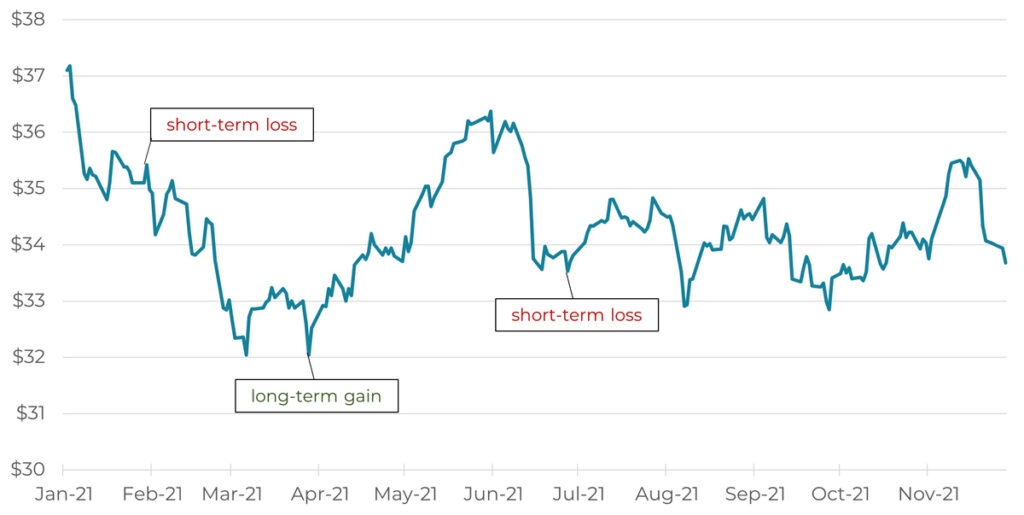A Tax Dilemma: How Capital Gains Can Hold Financial Advisors Hostage

While a series of profitable years is wonderful, we all know the ride comes to an end at some point. When that happens, financial advisors seeking to manage or reduce clients’ risk level can be held hostage to the gains that have built up in taxable accounts.
As advisors add new clients/accounts and plan for 2022, now is the time to consider approaches that reduce the risk of this scenario.
In addition to specific tax-loss harvesting strategies, the most simplistic approach, of course, is already used by most advisors when they help clients maximize returns by capitalizing on an assortment of accounts meant to defer taxes. However, since most of these tools have limits on how much can be contributed and stiff penalties for distributions per certain age requirements, it is common for clients to also have one or more taxable accounts.
While it may seem easy for an advisor to write off this concern of realizing gains to reduce risk as simply a cost of doing business, clients aren’t always so forgiving.
In an industry where unreasonable expectations are the norm, advisors may find themselves between a rock and a hard place. Lose money beyond a client’s “uncle!” point in a subsequent bear market and face being fired. Surprise the client (or their CPA) with an unusually large tax bill from capital gains and face the same result. You get the picture.
Unfortunately, once an advisor has already amassed a significant unrealized tax liability, the options are a bit limited. However, systematic investing expressed through trend following is a strategy that has been touted for its ability to reduce the risk of this scenario for new clients and accounts.
How Systematic Investing Can Build In Tax-Loss Harvesting
The traditional view of tactical asset management is that risk management and tax efficiency do not mix well. The conundrum is that:
- Most tactical managers do not place proper emphasis on taxes.
- Most tax-efficient portfolio strategies do not adequately account for portfolio risk.
However, trend following strategies can account for both. If the developer of the systematic investing rules properly values the importance of tax alpha while making tax management a cornerstone of their risk-managed processes, the strategy can be inherently tax friendly.
At Blueprint Investment Partners, we seek to accomplish this by incorporating a blend of timeframes in line with U.S. tax law:
- Shorter-term rules allow losing positions to be sold quickly when prices fall (because price is the chief input for our trend-following allocation decisions)
- Longer-term rules allow gains to be held if the trends persist, usually resulting in a portion of gains being harvested after 12 months
This process can result in a smoothing out of the tax profile, as well as a less choppy ride for clients.
2021 As A Case Study
In an average year, a trend following strategy built like what’s described above may realize more gains than a passive portfolio. But, somewhat counterintuitively, this does not necessarily reduce long-term compounding over full market cycles or generate an obstruction that threatens an advisor’s ability to make sound portfolio decisions.
This year has provided an example of how this works. Frequent tax-loss harvesting in Blueprint’s fixed income positions and certain equity sectors has, in most cases, has more than offset realized long-term gains in developed and emerging international markets. Despite all the inflation talk, commodities such as gold have been generally directionless for the year, allowing for additional loss harvesting.
To provide a more specific example: The iShares Gold Trust (IAU) is used within Blueprint’s risk-managed asset allocation portfolios, which use the timeframes described above. The chart below highlights points at which we have realized short-term losses and a long-term gain.
Applying Trend Following to iShares Gold Trust (IAU)

The losses have not been enough to meaningfully drag on the great returns provided by U.S. equities, and they have provided value from a tax perspective by offsetting current realized gains or being carried forward. The net result is that Blueprint’s risk-managed asset allocation portfolios have provided a strong return with realized net capital LOSSES.
Impact of Systematic Investing on Unrealized Capital Gains
To provide a further example, we ran a simulation that uses model performance to test the impact of trend following on unrealized capital gains. (Financial advisors can review the results of the simulation for themselves.)
Our model used the total return of the S&P 500 (expressed by the SPDR S&P 500 ETF Trust, SPY) since 2000 to compare a buy-and-hold portfolio to a one that utilizes the blend of trend-following timeframes described previously.
In our view, the data showed:
- Since 2000 most of a buy-and-hold portfolio was made of up unrealized gains. Therefore, a financial advisor looking to make any change to the portfolio or strategy would be likely to sustain a substantial taxable event.
- On the other hand, the trend-followed portfolio, which had a process for systematically harvesting losses (and some gains), maintained a more palatable amount in unrealized gains. All else equal, the flexibility afforded to the client and advisor when a strategy shift or liquidity is needed was considerably easier over this timeframe.
Impact of Systematic Investing on Pre- and After-Tax Returns
Given this result, you might assume the buy-and-hold strategy would outperform the trend-followed portfolio. We think the data showed one should not so quickly jump to conclusions.
Financial advisors can review an illustration that shows the pre- and after-tax returns for the buy-and-hold and trend-followed portfolios. With conservative assumptions about long-term tax rates, we think the data illustrated the potential for a trend-following strategy to generate tax alpha over longer-term time horizons.
Balancing Risk Management & Tax Efficiency
As I conclude, I think it’s important to note that tax considerations should be balanced with risk management. Research produced by Jon Robinson and me shows that maximizing compounding by avoiding large, sustained drawdowns is statistically more important to meeting financial goals than avoiding taxes. For most financial advisors, it makes more sense to pay taxes on gains than avoid taxes and make a zero return, or worse, incur large drawdowns to avoid realized gains.
That said, maximizing after-tax return is fundamental to goal achievement and psychologically important to clients. In a world where it can be difficult for advisors to stand out, offering a combination of risk management and tax management within portfolios can be a differentiator.
I hope that as advisors look ahead to 2022 and evaluate ways to avoid being captive to the markets and taxes, that they will consider approaches with baked-in tax efficiency.

Brandon Langley
Let's Talk
To discuss this topic in more detail
